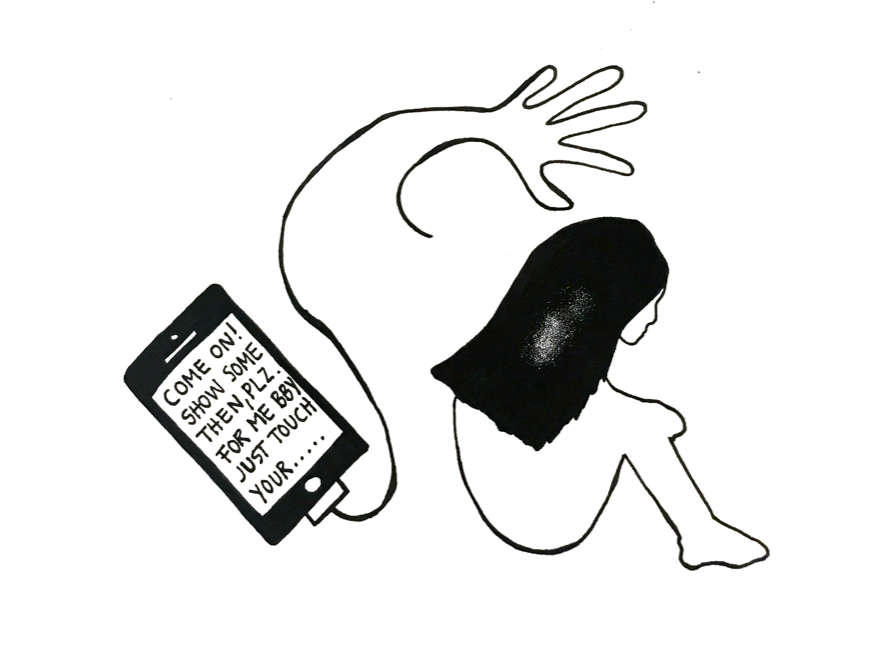Understanding Online Child Sexual Abuse and How to Talk to Children About it
The new digital technology provides children with endless opportunities to explore and communicate. Still, it is important to prepare them for potential risks that they might encounter online, just as we prepare them for potential risks in the offline environment. In this article, you will learn how to create a safer online environment by talking to children about the internet and online sexual abuse.
On a cold winter morning in March 2013, a 13-year-old girl committed suicide by jumping in front of a train in a quiet small town of Sweden. When the police investigation revealed why this young girl ended her life, it was a brutal awakening for the adult world. On the girl’s computer, the police found evidence that she had been coerced to pose sexually for her webcam. The offender, a boy, threatened to disseminate the revealing images unless the girl obeyed his demand to send more explicit photos. Later, the investigation revealed that this “boy,” in fact was a 44-year-old man. The investigation further revealed that he had contacted, and viciously threatened, more than 20 other young girls online (1). The aftermath of this tragedy led to debates on the online safety of children, with people asking how something that happened online could have such a severe consequence. This paper provides an explanation of this, as well as guidelines on how to talk to children about this important issue. Although most children are never victimized online, we have to prepare them to handle the potential risks in the same way we prepare them for the potential risks in the offline environment.
 Photo courtesy of Malin Joleby
Photo courtesy of Malin Joleby
Internet Use Among the Youth of Today
As a result of the rapid development of information and communication technology during the last few decades, digital devices and social media have become everyday aspects of our lives (How else would we find our way to the meeting, know when the museum closes, or remember our friends’ birthdays?). One can even go as far as saying that we live in media, rather than with media (2). Children growing up today have spent their entire lives surrounded by and using the internet in various forms (3).
The enormous increase in internet use is especially evident among youths. On average across countries within the Organization for Economic Co-operation and Development (OECD), 15-year-olds spend more than two hours online at home during a typical weekday and more than three hours during a typical weekend day. Furthermore, 26% of them could be considered “extreme internet users” (i.e. spending more than 6 hours online/day) on weekend days and 16% during weekdays. On average, almost a fifth began using the internet when they were younger than 6 years old (4). While this development might seem worrying for older generations, it is important to emphasize that internet can provide positive opportunities and experiences. These include opportunities to learn, access information, communicate, and socialize. Engaging in various forms of social media has been shown to benefit children and adolescents by enhancing their communication, social connection, and even technical skills (5). Without doubt, social media has dramatically changed the rules for social interaction in a short space of time (6), and with that comes a need for children to be aware of the possible risks that online communication might pose.
Adolescence: Identity Formation and Increased Sexual Curiosity
According to the psychosocial theory by Erik H Erikson (7), identity formation is one of the most central tasks of adolescence. The theory posits that one’s identity consists of three equally important parts: the biological, psychological, and social self. During adolescence, a series of changes occur in each of these parts; the body develops due to puberty, new thoughts regarding sex and romantic relationships might appear, and there are increased demands from society to take responsibility for one’s own actions. Taken together, these changes might give rise to an identity crisis, which should be understood as a turning point that fuels the establishment of self-identity. How well one copes with the crisis, is dependent on how well previous crises have been solved. One potential cause for problems, according to Erikson (8), occurs when society undergo such rapid changes that the adults no longer know the world of the youths.
One of the biggest changes during adolescence is the formation of sexual identity. At the same time, adolescence is a period of experimentation with risky activity (9). While none of the developmental changes that today’s adolescents experience are unique to this generation, digital technology provides new arenas for exploration. One way of exploring one’s sexuality online is by sexting. Sexting can be defined as sending, receiving, or forwarding sexually explicit messages, images, or photos to others through electronic means (10). The prevalence of sexting among adolescents younger than 16 varies between 15-26% for receiving sexts, and between 3-10% for sending or posting such messages (11, 12). When asked about the reasons for sexting, most youth described it as socially acceptable, a fun way to flirt, a part of a relationship, a way to explore ones sexuality, or a way of seeking affirmation (13).
What is alarming, though, is that 10% of youths who engaged in sexting reported that they had been coerced to do it (13). While sending the first pictures might be exciting and fun and seem safe, the situation can soon become frightening because once the first picture is received, the receiver has a hold on the sender. The pictures can be used to blackmail and coerce the sender into providing additional pictures. This is referred to as sextortion (14) and is exactly what the 13-year-old girl was subjected to. Unfortunately, her experience is not unique.
Grooming and Other Forms of Online Child Sexual Abuse
Another pitfall of internet use by children and youth is that they spend a lot time on it, unsupervised by adults (15). In addition, the anonymity of internet provides favorable conditions for people who want to develop manipulative relationships with children (16). Today’s technology also make it easier to find potential victims. Sex offenders sometimes target children by grooming them. In non-technological settings, this can involve preparing a child, significant adults, and the environment for the abuse of the child. The offender’s goals are gaining access to the child, gaining the child’s compliance, and having the child maintain secrecy, to avoid disclosure (17). Online, grooming can be done quickly, or might not be necessary. For instance, due to the adults limited involvement in the youth’s online lives, there is no need for grooming the significant others. The new technology also means that perpetrators have access to a great number of potential victims as the physical location does not impose any limitation. Once connected to the internet, children all over the world become potential victims, as the internet has no geographical borders. Perpetrators can, thus, choose to focus on the children who are most susceptible to grooming. The possibility to lie about one’s identity online further increases the opportunity for the perpetrators. In the case with the 13-year-old girl, the man posed as a boy her age. The contact between the two may never have occurred if the man had not been able to conceal his identity.
In recent years, a steady increase in the number of cases of grooming and online sexual abuse has been reported (18, 19). One possible explanation for the rise is that a greater awareness of online child sexual abuse has led to more people reporting. Nonetheless, it is also likely due, in part, to children’s increased access to digital devices, and today’s common practice of communicating via pictures (6).
Online grooming of children is prohibited by law in many countries (15) but governments often have a hard time revising legislation to keep up with new technology. While the laws usually target acts in which the perpetrator grooms a child online with the intent to later meet the child offline, they often do not explicitly criminalize pressuring and manipulating people to commit online acts themselves. These actions can include creating sexual images and videos, or interacting over webcam. The sexual acts can range from semi-nude posing, masturbating or penetrating oneself, to performing sexual acts with another person or an animal (20). It is obvious that the legislation needs an update, otherwise the children who are exposed to these crimes will not receive the legal justice that they deserve.
Online Sexual Abuse Could Be Equally Harmful as Offline Sexual Abuse
The psychological consequences of being subjected to child sexual abuse can be severe. While not all children with experience of child sexual abuse are traumatized, research has shown that it can lead to an increased risk of anxiety, depression, post-traumatic stress, eating disorders, suicidal and self-injurious behavior, self-esteem impairment, interpersonal problems, and sexual dysfunction (21). Many people, however, underestimate the trauma that online child sexual abuse can cause (22) because of their perception that the offline world is “real life,” which implies that things that happen online are separate from real life, thus, perhaps less real. This distinction might be one explanation to why offline contact abuse is viewed as more adverse than non-contact online abuse. Recent research, however, contradicts this view. In a study by the National Society for the Prevention of Cruelty to Children (23), children with experience of online sexual abuse were screened for posttraumatic stress, and four out of five achieved a score consistent with a diagnosis of posttraumatic stress. In another study on high school students, children with experience of online sexual abuse reported higher prevalence of post-traumatic stress symptoms than children with experience of offline sexual abuse did (24).
The nature of online sexual abuse might make it at least as harmful as offline sexual abuse. First, in online sexual abuse the children are often “directed” to perform sexual acts on themselves. This can complicate their understanding of what they have been subjected to by creating confusion around the role of perpetrator/victim (e.g., “He never touched me, can he really be called a perpetrator?”). In addition, this can lead to increased feelings of shame, guilt, and blame (e.g., “I took of my clothes. I did this to myself.”). It is not uncommon for people who have been sexually abused to feel guilty for not being able to stop the abuse (23, 25), and, speculatively, this might be even more so for those abused online, because the perpetrator was not physically present. To lessen the burden of shame, it is important to understand the power and impact that sexual perpetrators exert over their victims (26), whether the abuse is conducted offline or online. Second, cases of online abuse often contain pictures and/or videos of the abuse, which might have a detrimental effect for the child who is exposed. A study on children who had experienced offline sexual abuse and had their abuse pictures disseminated online indicated that knowing these pictures might be viewed by an incalculable number of people was traumatizing (26). To illustrate: when she was between 7 and 9 years old, a girl was coerced to touch herself in front of her own father, who photographed the abuse and sold the pictures online. The girl described the shame, guilt, and blame of living with the memories of what her father coerced her to do. However, what she described as even more distressing was that potentially thousands of other people could view the images. The permanence of the pictures might lead to feelings of the abuse never ending (26, 27). In contrast to contact abuse, which is connected to a certain time, place, and perpetrator, having one’s images disseminated means there may be unknown perpetrators all over the world who can see the pictures at any time. This lack of closure might complicate the recovery process. Children who have their abuse pictures disseminated online not only have the psychological pressure of processing the trauma of the abuse, but also of developing strategies to deal with the ongoing dissemination (26). In the case with the 13-year-old girl, this psychological pressure became unbearable.
 Illustration by Jennifer Stråle
Illustration by Jennifer Stråle
What Can We Do?
Although most children are never victimized, everyone in contact with children and youth — from parents and guardians to school personnel, sport leaders, and law enforcement agencies — should be aware of the risks that children might encounter online. And they should be prepared to talk to them about it. This is a crucial step toward creating a safer online experience for children (15).
It is easy to feel discouraged by the horrific stories of young children being exploited online, but putting all the blame on the new technology is a far too easy a way out. Rather, we need to adapt to this use of technology and teach children how to handle it safely.
From a psychological point of view, it is important to understand the developmental changes that adolescents are going through, and that the sexual curiosity often starts far earlier than adults might acknowledge. A child who initiated the first contact often has feelings of guilt and blame that makes it difficult for them to ask for help, if the situation escalates into something other than planned (28). It is therefore of utmost importance that we learn to talk about these issues with our children, without blaming them for their behavior.
The Save the Children guidelines (28) on age-appropriate ways to talk about the internet with our kids is a valuable source of help. The organization developed the guidelines in collaboration with police, child psychologists, and affected children (read them here). While the organization recognizes that it might feel unmanageable to keep track of all our children’s online activities, it emphasizes that the most important precaution we can take is sharing the internet-related activities and experiences with our children. It should be as natural to ask “What was it like on the internet today?” as asking “How was school today?” The guidelines (28) can be summarized as follows:
From 2 years
- Just as you do not leave children unattended in a large city, do not leave them alone online.
- Engage and show interest in the child’s online activities, and explore them together.
4–5 years
- Introduce the subject of online risks – e.g. “There are people online that pretend to be nice but want to harm children.”
- But try not to frighten them, as fear might trigger curiosity.
6–12 years
- Explain how it can be difficult to tell good people from bad people online.
- Explain that anyone can fake a picture, and not everyone is the person they claim to be.
- Explain the speed at which pictures can be spread online and that they must not post or send pictures of themselves if it does not feel ok.
- Avoid outright bans. Instead, ask the child to talk with you before continuing to connect with an unknown person online.
13–19 years
- Continue to talk with the child about what they do online.
- Even if it feels uncomfortable, talk about sexual abuse with the child. Remind them of their right to their own bodies and the right to say no.
- Assure the child that it is never too late to tell you about possible abuse, even if they have done something they regret.
We as adults are responsible for teaching our children about the world, but we have to remember that we also can learn a lot from them. So, let us learn from the tragic fate of the 13-year-old and use it to better understand the online world of our children. With the right guidance, the internet can be an amazing area of opportunities for them.
Lastly, do not lose hope. The vast majority of children are never victimized. If we start talking about these issues with children, we can reduce their vulnerability (28) and prevent them from becoming exposed to online child sexual abuse.
References
- Janke, E., and Aslan, G. (Producers and Hosts). (2007, March 5). Kumlafallet [Radio documentary]. In E. Janke (Producer), P3 Dokumentär, Sweden: Radio Sweden.
- Deuze M. Media life. Media, Culture & Society. 2011;33(1):137-48.
- Prensky M. Digital natives, digital immigrants part 1. On the horizon. 2001;9(5):1-6.
- OECD. PISA 2015 Results (Volume III): Students’ Well-Being, PISA. Paris: OECD Publishing. http://dx.doi.org/10.1787/9789264273856-en
- Ito M, Horst HA, Bittanti M, Stephenson BH, Lange PG, Pascoe C, et al. Living and learning with new media: Summary of findings from the Digital Youth Project: MIT Press; 2009.
- Swedish Media Council. Ungar och medier 2017. 2017.
- Frisén A, Hwang P. Ungdomar och identitet. Stockholm: Natur och kultur; 2006.
- Hwang P, Nilsson B. Utvecklingspsykologi. Stockholm: Natur och kultur; 2003.
- Steinberg L. Adolescence. McGraw-Hill; 2011.
- Klettke B, Hallford DJ, Mellor DJ. Sexting prevalence and correlates: A systematic literature review. Clinical psychology review. 2014;34(1):44-53.
- Livingstone S, Haddon L, Görzig A, Ólafsson K. Risks and safety on the internet: the perspective of European children: full findings and policy implications from the EU Kids Online survey of 9-16 year olds and their parents in 25 countries. 2011.
- Burén J, Lunde C. Sexting among adolescents: A nuanced and gendered online challenge for young people. Computers in Human Behavior. 2018;85:210-7.
- Jonsson L, Cooper K, Quayle E, Svedin CG, Hervy K. Young people who produce and send nude images: Context, motivation and consequences. 2015.
- Wolak J, Finkelhor D, Walsh W, Treitman L. Sextortion of Minors: Characteristics and Dynamics. Journal of Adolescent Health. 2017;62(1):72-9.
- Children ICfME. Online Grooming of Children for Sexual Purposes: Model Legislation & Global Review. 2017.
- Swedish National Council for Crime Prevention [BRÅ]. Vuxnas sexuella kontakter med barn på internet. 2007.
- Craven S, Brown S, Gilchrist E. Sexual grooming of children: Review of literature and theoretical considerations. Journal of Sexual Aggression. 2006;12(3):287-99.
- Swedish National Council for Crime Prevention. Statistics of reported crimes [Internet]. Stockholm: Swedish National Council for Crime Prevention. [cited 2018 Sep 11]. Available from: http://statistik.bra.se/solwebb/action/index.
- Bentley H, O'Hagan O, Raff A, Bhatti I. How safe are our children? The most comprehensive overview of child protecion in the UK. NSPCC - National Society for the Prevention of Cruelty to Children. 2016.
- Joleby M, Landström S, Lunde C, Jonsson L. "Basically you are raping me.": Online child sexual abuse victim's experiences, feelings and mental health issues. Unpublished.
- Maniglio R. The impact of child sexual abuse on health: A systematic review of reviews. Clinical psychology review. 2009;29(7):647-57.
- Whittle HC, Hamilton-Giachritsis C, Beech AR. Victims’ voices: The impact of online grooming and sexual abuse. Universal Journal of Psychology. 2013;1(2):59-71.
- Hamilton-Giachritsis C, Hanson E, Whittle H, Beech A. Everyone deserves to be happy and safe - A mixed methods study exploring how online and offline child sexual abuse impact young people and how professionals respond to is. 2017.
- Jonsson L, Svedin CG. Barn utsatta för sexuella övergrepp på nätet. 2017.
- Janoff-Bulman R. Characterological versus behavioral self-blame: inquiries into depression and rape. Journal of personality and social psychology. 1979;37(10):1798.
- Leonard MM. “I did what I was directed to do but he didn't touch me”: The impact of being a victim of internet offending. Journal of Sexual Aggression. 2010;16(2):249-56.
- Svedin C, Back C. Why didn't they tell us? On Sexual abuse in Child Pornography. 2003.
- Save the Children. #Nätsmart Tips och råd för att förebygga sexuella övergrepp mot barn på internet. 2015.



